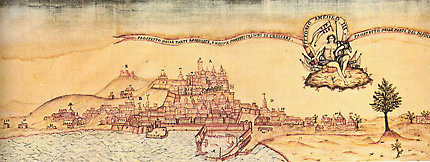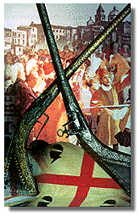
From 1720 to 1847, and again in 1861 with the Proclamation of Italian Unity, Cagliari
experienced various political events of greater importance than any occurring during
the Spanish period.
The events of the French Revolution found sympathizers among
intellectuals, but the Church spread anti-French sentiment among the masses and portrayed
the events of '89 as ungodly. Thus, when a revolutionary French fleet under the command
of Admiral Truguet appeared on February 28, 1793, and the troops landed at Quartu, they were
met by Sardinian militiamen commanded by Girolamo Pitzolo. A bloody battle
took place on the S.Bartolomeo plain, in which the French troops were scattered and
forced to take to their ships.
The Stamenti took advantage of this victory to petition the king to approve a request
based on five points. Primary among them was the age-old Sardinian problem of obtaining
positions in government. Again no solution was found.
Inspired by the Stamenti, an anti-Piedmontese uprising took place. On May 7,1794,
the Piedmontese were conducted to the port, forced to board a ship, and expelled
from the island. Nowadays the festival "
Sa Die de sa Sardigna"
calls to mind that event.
Although Turin swiftly responded by sending a new Viceroy, Marquis Vivalda, the consequences
of the revolt were serious. Girolamo Pitzolo, acclaimed in triumph by the rebels
upon his return from Turin, was named Quartermaster General by the king of Savoy
in an attempt to satisfy the long-standing demand for Sardinian political equality.
He soon fell out of favor with the Stamenti and was killed by demonstrators as he
was being taken to prison.
After the Napoleonic Wars, three representatives of the Stamenti met with Carlo Emanuele
IV, king of Sardinia, at Leghorn. The sovereign had surrendered to the French on
December 8,1798. The three spokesmen invited him to leave Turin and move to Cagliari,
where he arrived with his family on March 3,1799.
|







